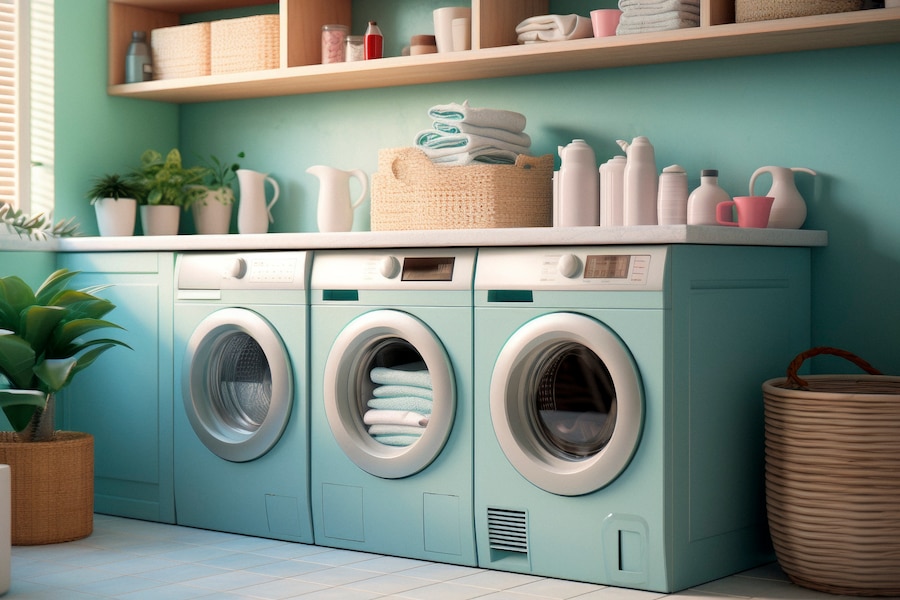Living in a small laundry room can often feel like a never-ending battle for space. This compact area is expected to house an array of items, from washing machines and dryers to cleaning supplies and clothing. It should make daily chores more manageable and create a more organised and aesthetically pleasing living environment. Today, the challenge is to make the most of the limited square footage without compromising functionality or comfort.

Here are the six must-try solutions that maximise storage potential in small laundry rooms:
1. Going Vertical with Storage
Consider the potential of vertical storage when floor space is lacking. This method provides an environment devoid of congestion, enhanced accessibility, and increased organisation, among other advantages.
Incorporating bookcases into your tiny laundry room can effectively maximise the wall space available. Select adjustable shelving configurations and heights to suit your specific requirements. This adaptability permits the storage of linen detergent bottles and folded towels, among other items, of varying proportions.
Solid wood, metal, or melamine, all resilient and moisture-resistant, should be used to construct your shelves. These materials support your stowed items and can withstand the humidity common in laundry rooms.
Consider the aesthetic of your laundry room when choosing shelving styles. Closed cabinets offer a more streamlined appearance and aid in the concealment of clutter, whereas open shelves provide visibility and simple access. Personalise a storage solution that is both distinctive and practical by combining various designs.
Hooks, rods, or rails are hanging systems that may be integrated with shelving. Ironing boards, clothing hangers, and delicate garments are ideal storage and drying utensils within these fixtures. Ensure they are installed at a practical and comfortable height before daily use.
2. Secret Storage Solutions
While maintaining an orderly, uncluttered appearance, concealed storage solutions can help you maximise functionality.
Unutilised areas, such as the space between appliances or beneath the washer and dryer, could be transformed into functional workspaces with pull-out compartments. These compact containers conveniently store cleanliness supplies, laundry essentials, small undergarments, and socks. You can maintain a more streamlined and orderly laundry area by storing these items away.
When the laundry room has alcoves or recessed areas, built-in cabinets may be a useful addition to maximise the use of this space. These bespoke storage solutions can be tailored to complement the laundry room’s layout and provide sufficient storage space without compromising on aesthetics or practicality.
Consider using multipurpose furniture in a tiny laundry room. Dual-purpose pieces, including bench seats that conceal compartments and collapsible tables that incorporate storage provisions, are available. These multifunctional objects optimise overall functionality by offering supplementary storage space.
Incorporating a concealed receptacle into the laundry room’s design can create an undetected laundry area. Use a decorative basket that glides effortlessly under a shelf or countertop or install a tilt-out hamper within a cabinet.
3. Choosing the Right Appliances
Space-efficient and functional appliance selection is of the utmost importance. Selecting appropriate washing machines guarantees the effective completion of laundry duties while preventing the overcrowding of a confined space. As an example, space-saving appliances:
- Stackable laundry units: Stackable washer and dryer units are one of the most efficient methods of conserving space in a small laundry room. They require only half the available floor space and can be installed one upon the other. By arranging the washing and drying machines vertically, this arrangement utilises the space-constrained area to its fullest extent while providing added convenience.
- Front-loading machines: Compared to top-loading systems, front-loading washers and dryers are generally smaller, making them well-suited for compact laundry rooms. Also, loading and unloading items does not require reaching above the appliance, facilitating simpler access to the front-loading models.
- A combination washer-dryer appliance is advisable for areas with limited space. These all-in-one appliances obviate the necessity for distinct devices by incorporating washing and drying functions into a single machine. Notwithstanding their lengthier cycle times, combination washer-dryers can be an excellent space-saving option.
Expert tips: Before purchasing, carefully consider the appliances’ compact dimensions. Consider purchasing machinery with reduced widths and depths to complement your minuscule laundry room more effectively. Also, before purchasing, ensure that the selected appliances adequately fit within the designated area by taking precise room measurements.
4. Retractable Folding Tables and Ironing Boards
Consider installing retractable surfaces for ironing and arranging garments to optimise space use and preserve functionality. When not in use, store them conveniently. These ingenious features optimise the use of your restricted space.
When it comes to tiny laundry rooms, folding tables are highly adaptable. It can be conveniently collapsed and positioned behind a door or against a wall when not in use. Mount a piece of plywood or another robust, lightweight material to wall-mounted hinges to construct a do-it-yourself folding table. On the other hand, an alternative option would be to acquire a prefabricated foldable table that is wall-mounted and can be collapsed seamlessly.
Conventional pressing boards are cumbersome and require extra space in a limited-space laundry room; retractable ironing boards eliminate this issue. Conversely, a retractable ironing board can be packed away compactly when not in use. Ironing boards that collapse into recessed cabinets, where they are concealed when not in use, are a popular alternative. A wall-mounted ironing board that folds away from the wall and can be locked in position while in use is an additional technique for conserving space.
If you possess the necessary manual skills, consider constructing a bespoke cabinet to accommodate a portable ironing board. Produce a basic timber frame featuring a hinged door to mount the ironing board securely. Securely seal the cabinet door when not in use to ensure a streamlined and uncluttered appearance.
5. Organisational Accessories
Different varieties of containers can efficiently store and classify your laundry necessities, facilitating their identification when necessary.
Containers and receptacles are multifunctional, aesthetically pleasing, and ideal for arranging laundry provisions. To guarantee long-lasting quality, select containers constructed from resilient materials such as plastic, metal, or woven fabrics. These receptacles house laundry detergent, fabric softener, stain removers, and other cleaning goods. Select bins and baskets in a uniform colour scheme or material to establish a harmonious appearance that enhances the aesthetic of your laundry area.
Glass or plastic jars and canisters are ideal for keeping small objects such as clothes pegs, safety pins, or washing machine tablets. These containers keep your laundry essentials ordered while adding a decorative element to your room. Ensure clear identification of your jars and canisters to facilitate quick recognition and uphold a neat and organised aesthetic.
Organise your soiled garments by using a laundry sorter equipped with numerous sections. This feature lets you categorise your clothing items based on their colour, fabric composition, or family members, optimising and simplifying your laundry routine. Select a tiny sorter that can easily fit into your small laundry room.
6. Door Dynamics
Rear door components are an area that is frequently neglected. You can create additional storage space and alter the appearance of your door into a functional element of the room by utilising this area to hang over-the-door organisers and fashionable accessories.
These adaptable storage solutions—over-the-door organisers—ensure that frequently used items are always accessible. Laundry detergent, fabric softener, stain removers, and additional cleaning supplies should be stored in an organiser featuring multiple pockets or compartments. Some organisers have hooks that can suspend objects such as garment bags, ironing board covers, or drying racks.
Consider installing hooks or railings on the rear of the laundry room door to accommodate items such as robes, clothes hangers, or small handheld tools. This will help maintain a clutter-free environment and organise your possessions.
If your laundry room door is made of metal, consider using magnetic storage containers to enclose small items such as safety pins, scissors, and clothing pegs. These receptacles are practical and space-efficient, effortlessly affixed and detachable from the door.
Installing a chalkboard or mirror on the back of the laundry room door will convert it from an unsightly presence to a practical and fashionable accent. While a chalkboard offers a practical surface for writing down laundry-related duties, reminders, or notes, a mirror can create the illusion of a more spacious area.
Wallpaper, decals, or paint are decorative embellishments that could elevate the laundry room door’s appearance. Elect a layout that harmonises with the preexisting interior design and establishes a unified aesthetic across the entire area.

Tiny Laundry Room? No Problem! We can help you out!
If you’re looking for more extensive renovations or personalised advice, don’t hesitate to contact Butler Bathrooms+. Our team of experts is here to help you create the laundry renovation of your dreams, no matter the size or layout. Together, we can turn your small laundry room into a functional and beautiful space you’ll love using daily.



